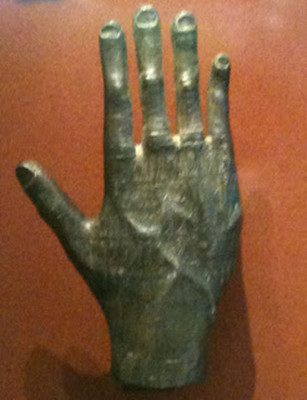The first four programmes this week have been about religions that have millions, or hundreds of millions, of followers, but 1,700 years ago there were far more religions in the world than today, and many, many more gods. Gods at this date tended to have strictly local responsibilities, not the worldwide embrace that we're used to now. In Mecca, for example, before Mohammed, pilgrims worshipped in a temple which had a statue of a different god for every day of the year. Today's programme is about one of those numberless Arabian gods, that didn't survive the coming of Mohammed.
本周我們為您帶來的前4件物品有數百萬或成千上萬的追隨者,約1700年前,世界上的宗教與神遠比現在要多。當時的神多具有地域性,而非像現在一樣通常為全球各地的人民信仰。例如在麥加,在人們追隨穆罕默德之前,朝圣者們進神廟敬拜,每天敬奉的神像都不相同。我們這部分的最后一件文物便是獻給后來被穆罕默德禁信的眾多阿拉伯本土神祇之一的。
His full name was Ta'lab Riyam, meaning "the strong one of Riyam"-a Yemeni hill town-and he protected the local hill people. Yemen in the third century was a prosperous place, a hub of international trade that produced some of the most sought-after commodities for the vast market of the Mediterranean, the Middle East and India. It was Yemen that supplied the whole Roman Empire with frankincense and myrrh.
他的全稱是塔拉布·里陽,意為“里陽的神”。里陽是也門的一座山丘城鎮,而塔拉布庇佑著這里的山區百姓。公元三世紀的也門是個繁華之地,它是一個國際貿易集散地,出產一些在地中海、中東和印度市場都需求極大的物品,并為整個羅馬帝國提供乳香和沒藥。
I'm in the study room of the British Museum, and I'm holding the hand of a man called Wahab Ta'lab. It's a life-sized hand, just slightly smaller than my own, made of bronze, and it is surprisingly heavy. It's very lifelike, but as it's got no arm attached to it, it does look as though it's been severed. But according to Jeremy Field, orthopaedic and hand surgeon at Cheltenham General Hospital, this is not the case:
我現在正身處大英博物館,我們這只銅手的原主人名為瓦哈·塔拉布。它的大小與真人的手相當,僅比我的略小一號,由青銅制成,很有分量。這手看起來惟妙惟肖,但沒有手臂,仿佛是從手臂上切下來一般。但切爾滕納姆綜合醫院的整形外科及手外科醫生杰瑞米·費爾德認為,事實并非如此:












